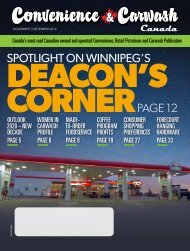Convenience & Carwash Canada January-February 2020 issue
trade publication for Carwash, Petroleum & Convenience Stores
trade publication for Carwash, Petroleum & Convenience Stores
You also want an ePaper? Increase the reach of your titles
YUMPU automatically turns print PDFs into web optimized ePapers that Google loves.
14 JANUARY/FEBRUARY By Steve Samudio, Paul Spence and Denise D. Wight
Water Saving Strategy for Carwash
Operators and How to Implement
Water restrictions or not, there’s good reason to make a
commitment to water conservation and water reclamation
in the carwash industry. Water and sewer costs have
increased an average of 50 per cent since 2008.
Reclaiming water is a
necessary part of the
modern-day carwash.
By minimizing the
amount of water
discharged out to
the sewer you are
reducing waste,
taking care of the
environment and
saving money.
Water and sewer costs are becoming
the number one operating expense for
carwash operators. Companies should
be actively managing water use because
doing nothing now will cost more
later. There are many steps operators
can take; from checking for leaks and
limiting flow through nozzles to RO
reject recovery, but the most effective
way is through water reclamation.
WHAT IS RECLAIM? The definition
of reclaim is “to retrieve or recover
something lost.” Reclaim, by carwash
industry definition, is the re-use of
previously used water in the carwash
process. It is important to note that a
small percentage of the wash water is
lost due to evaporation and carryout.
Let’s talk about the water we can recapture
and re-use. There are three
main sources; Reverse osmosis (RO)
reject water, rainwater and reclaimed
carwash water.
1. Reverse osmosis (RO) reject water:
A Reverse osmosis system uses city
water in the process of making spotfree
water. The byproduct of this
process is called reject water. RO
reject water has been treated for
chlorine by the carbon filter and has
gone through a five-micron prefilter
but is high in total dissolved solids
(TDS). The high TDS negatively




